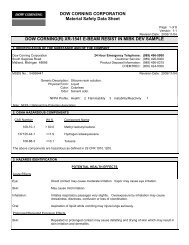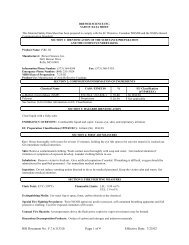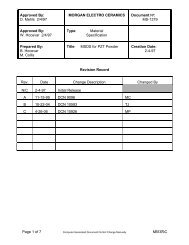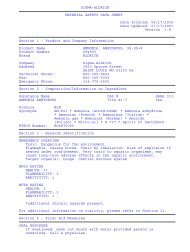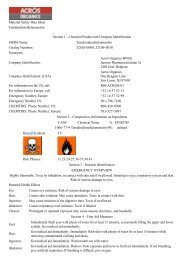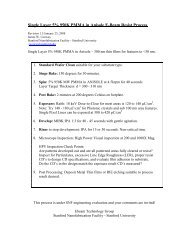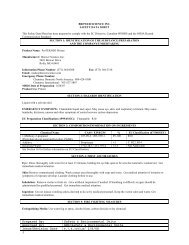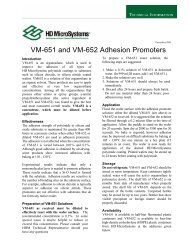MSDS M10 - Stanford Nanofabrication Facility
MSDS M10 - Stanford Nanofabrication Facility
MSDS M10 - Stanford Nanofabrication Facility
Create successful ePaper yourself
Turn your PDF publications into a flip-book with our unique Google optimized e-Paper software.
Beryllium Solid <strong>MSDS</strong> No. <strong>M10</strong> January 1, 2010<br />
The presence of salts in water, particularly chloride, dramatically accelerates the corrosion of beryllium. This<br />
corrosion can be further accelerated (galvanic corrosion) if beryllium is in contact with a less reactive metal.<br />
Contrarily, beryllium can be protected from corrosion by contact with a more reactive metal (anodic<br />
protection).<br />
Generally, some corrosion protection should be applied to beryllium. Salts from handling beryllium without<br />
gloves along with humidity in the air are sufficient to cause “finger print” corrosion on a bare beryllium part.<br />
A chromate conversion coating is an effective protection for non-severe service.<br />
For applications where beryllium is exposed to salt spray or mist, an integral coating is needed to prevent<br />
corrosion. The conversion coating alone will not protect beryllium in salt spray applications. Conversion<br />
coating in combination with anodic protection with manganese or magnesium has been effective in protecting<br />
beryllium brake components on aircraft carrier based planes. Electroless nickel, epoxy paint and other integral<br />
coatings are effective corrosion barriers in salt spray applications.<br />
8.12 EXPOSURE CHARACTERIZATION<br />
Determine exposure to airborne particulate by air sampling in the employee breathing zone, work area, and<br />
department. Utilize an Industrial Hygienist or other qualified professional to specify the frequency and type of<br />
air sampling. Develop and utilize a sampling strategy which identifies the extent of exposure variation and<br />
provides statistical confidence in the results. Conduct an exposure risk assessment of processes to determine if<br />
conditions or situations exist which dictate the need for additional controls or improved work practices. Make<br />
air sample results available to employees.<br />
8.13 MEDICAL SURVEILLANCE<br />
Beryllium: Medical surveillance for beryllium health effects includes (1) skin examination, (2) respiratory<br />
history, (3) examination of the lungs, (4) lung function tests (FVC and FEV1), and (5) periodic chest x-ray. In<br />
addition, a specialized, specific, immunological blood test, the beryllium blood lymphocyte proliferation test<br />
(BLPT), is available to assist in the diagnosis of beryllium related reactions. Individuals who have an abnormal<br />
BLPT are normally referred to a lung specialist for additional specific tests to determine if chronic beryllium<br />
disease is present. Note: Substantial inter- and intra-laboratory disagreement exists among the laboratories<br />
that conduct this test. The BLPT does not at this time meet the criteria for a screening test. Despite its<br />
limitations, however, the BLPT remains a useful disease surveillance tool.<br />
8.14 RISK FACTORS<br />
Specific genetic factors have been identified and have been shown to increase an individual’s susceptibility to<br />
CBD. Medical testing is available to detect genetic factors in individuals.<br />
8.15 OCCUPATIONAL EXPOSURE LIMITS<br />
Brush Wellman recommends following good industrial hygiene practice which includes reducing airborne<br />
exposures to the lowest feasible level for all constituents in this product. Brush Wellman recommends that<br />
users of beryllium-containing materials maintain worker exposures to airborne beryllium to levels reliably<br />
below its recommended exposure guideline (REG) of 0.0002 milligrams beryllium per cubic meter of air.<br />
CONSTITUENTS<br />
OSHA*<br />
ACGIH*<br />
NIOSH RTECS<br />
NUMBER<br />
PEL CEILING PEAK TLV TLV-STEL<br />
Beryllium 0.002 0.005 0.025 0.00005 N/A DS1750000<br />
*ALL CONCENTRATIONS ARE IN MILLIGRAMS PER CUBIC METER OF AIR<br />
(at the concentrations noted above, these constituents may not be visible to the human eye)<br />
Page 7 of 11




